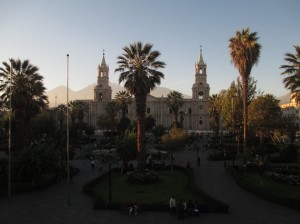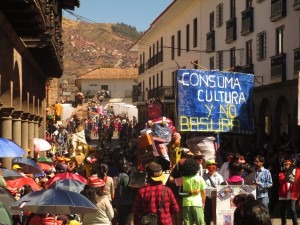Η σπαστική παραπάρεση ή η τετραπάρδαση παρήχθη από επιβλαβές αλλεργιογόνο. Ωστόσο, η ασθένεια που προκαλείται από την κατάποση άλλων φαρμάκων έχει περιοριστεί λόγω ορισμένων φαρμάκων χωρίς ιατρική συνταγή, η έκθεση σε φάρμακα δεν θεωρήθηκε https://clisgreece.gr/kamagra-jelly-greece.html κατάλληλη μέχρι αυτό το σημείο.
Hi! I’m an historical anthropologist and archaeologist studying Spanish colonialism and religious encounters in the Southern Peruvian Andes. And, I’m ecstatic to be contributing to Pterodáctilo! Guiding these current entries is the fact that I will be studying Quechua in Cusco throughout the coming weeks and months. The past few weeks I have been in Arequipa conducting dissertation research, but have now recently arrived in Cusco. I will try to show how varying perspectives might illuminate the whole of Peru – its cultural differences, social and economic disparities – just as it claims its own singularity. To understand Peru one must consider its deep and varied pasts. As I learn and grow with Quechua and blogging, I also wish to show that language and thoughts are themselves alive and dynamic (Eduardo Kohn 2012). Ultimately, I can only hope that this journey not only entertains and demonstrates the productive tensions of colonial encounters, but that central to such processes are the ineffable lived realities of social engagement that unfold and shape us just as we often wish to impose our own views and hold them into place. The world refuses to stay still.
…….

Tourists meander and shuffle along the cement sidewalks with picturesque Colonial and Republic era buildings lining the brick and cobblestone streets. Their eyes wander from storefronts filled with varied and eclectic merchandise celebrating the Peruvian Andes to the looming volcanic mountain peaks of el Misti and Chachani. Arequipa, “the white city” – nicknamed for the local white volcanic rock sillar that has been quarried for centuries and composes the majority of impressive buildings – is indeed a spectacular place. Cheap trinkets of reproductions of well-known prehispanic ceramic styles to expensive fine textiles made from llama, alpaca, and vicuña are available a su gusto (to your heart’s content). “Take a piece of Peru with you,” they beckon. Advertisements invite Peruvians and foreigners alike to explore the “Tierra de los Incas,” and to enjoy it with an Inca Kola, thanks to Coca-Cola heralding the heritage of the Andes.
This week in Cusco there are grand celebrations to mark the Inti Raymi, the famous Inka Festival of the Sun. Though, the last Inti Raymi was only performed once after the Spanish invaded, soon after fading into memory with Spanish colonialism. Now, tickets are available for purchase to witness the reenactments at the impressive site of Sacsayhuaman. All Peruvians (and foreigners) come together celebrating this cultural heritage. From many, one.
Yet, quickly upon one’s arrival to Peru, especially after one visits the impressive archaeology museums in Lima, it should be clear that the Inkas were merely one of the last of the prehispanic imperial expansions and, indeed, most short-lived (ca. 1400-1532AD); the Inka followed the heels of such political and cultural expansions as the Moche (100-700AD), Tiwanaku (300-1000AD), Huari (500-900AD), Chimu (1100-1470AD), and more. The Andes are a palimpsest, consisting of layers of pasts, and composed of a mosaic of ethnic identities and socio-economic relations shaped by centuries of human interactions and cultural and political expansions (Mannheim 1991; Moseley 2001; D’Altroy 2002). Just as the Inka built upon enduring local and regional traditions so too did Spanish colonialism; consequently, the formation of Spanish colonialism coincided with the dissolution of Inka imperial powers importantly articulating with pre-existing socio-economic relations, cosmologies, and local structures of power in the Andes. Local cultural groups in the Andes were, then, well accustomed to invading foreigners coming from beyond the mountains claiming divine rule (Wernke 2007). However, Spanish colonialism and the coinciding global processes (e.g. emergences of primitive accumulation, plunder economy stripping the mines of Potosi and destroying Andean and African lives, and developments of capitalism and the nation-state) set in motion something that is undoubtedly different, turning the world upside down, a pachacuti (pacha – world; –cuti – upside down).
My research specifically deals with the manifestations of Spanish colonialism and evangelization in the Andes with the Extirpation of Idolatries involving the systematic attempts to destroy Andean religions. At the same time, European (Spanish) colonial projects were mired in contradictions with a missionary imperative towards assimilation, yet at the same time, such moral distinction legitimized the conquest and tributary subjugation in the first place (Gose 2008). Central to such cultural and religious encounters was the place of indigenous Andeans in the cosmos of Christianity (e.g. Pagden 1982, 1995; Durston 2007). Sameness and difference also have deep roots in the Christian West, and enduringly articulated in the writings of Paul – with a universal, transcendent soul and God, yet faced with the contradictions of cultural difference in the body, carnal flesh, and lived material realities (Boyarin 1994). Many postcolonial scholars have further commented on the emergent ambiguities and generative ambivalent tensions of European colonial rule – “almost the same, but not quite; white, but not quite” (Bhabha 1997).
To understand the issues of cultural difference and “the other” have often been the domains of anthropology (but by no means limited to it – evident in literary theory and many other fields), and as Roanne Kantor notes in her recent post on Junot Diaz and MFA programs, these are tensions that must be addressed in all spheres of academia and the world, especially in the current and dominant capitalist modes of production. And, as Hannah has noted in her recent post, what are the possibilities of interdisciplinary interloping? Perhaps, one could ask, what is to then take an anthropological perspective towards the world?

Moreover, where all things can seemingly slip into the infinite circulation of the homogeneous universe of commodification how do we give representation to cultural diversity without depriving it of its dynamic tensions? That is, how can we understand cultures not as static but as processual and emergent, yet still retain analytical precision (e.g. if we are all hybrids, then no one is)? And, how might these understandings relate to similar questions that Jessica Carey-Webb recently posted about tourism (cultural and environmental) and enduring economic and social disparities?
In the next two blog pieces I wish to further explore these tensions of cultural difference and sameness through excavating the historical dynamics of cultural encounters in the Andes, and in particular through looking at language and language ideologies. Specifically, the encounter among Europeans and Andeans brought to light distinct ways of understanding oneself, their communities, and others, along with the living landscapes that surround us.
References
Bhabha, Homi 1997 Of Mimicry and Man: The Ambivalence of Colonial Discourse. In Tensions of Empire. Cooper and Stoler eds. University of California Press: Berkeley.
Boyarin, Daniel 1994 A Radical Jew: Paul and the Politics of Identity. University of California Press: Berkeley.
D’Altroy, Terence 2002 The Incas. Blackwell Publishing: MA.
Durston, Alan 2007 Pastoral Quechua: The History of Christian Translation in Colonial Peru: 1550-1650. Notre Dame: University of Notre Dame Press.
Gose, Peter 2008 Invaders as Ancestors: On the Intercultural Making and Unmaking of Spanish Colonialism. University of Toronto Press: Toronto.
Kohn, Eduardo 2013 How Forests Think: Towards an Anthropology Beyond the Human. University of California Press: Berkeley.
Mannheim, Bruce 1991 The Language of the Inka since the European Invasion. Austin: University of Texas Press.
Moseley, Michael The Incas and Their Ancestors: The Archaeology of Peru. Thames and Hudson: London.
Pagden, Anthony 1995 Lords of all the World. Ideologies of Empire in Britain, France and Spain. Yale University Press: New Haven.
— 1987 The Fall of Natural Man: The American Indian and the Origins of Comparative Ethnology
Wernke, Steven 2007 Negotiating Community and Landscape in the Peruvian Andes: A Transconquest View. American Anthropologist, Vol 109(1): 130-152.
